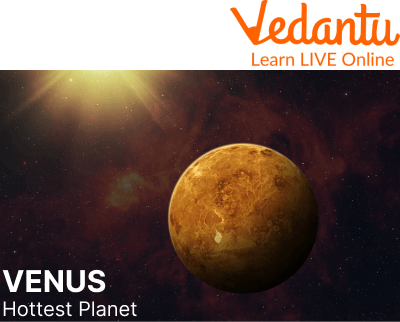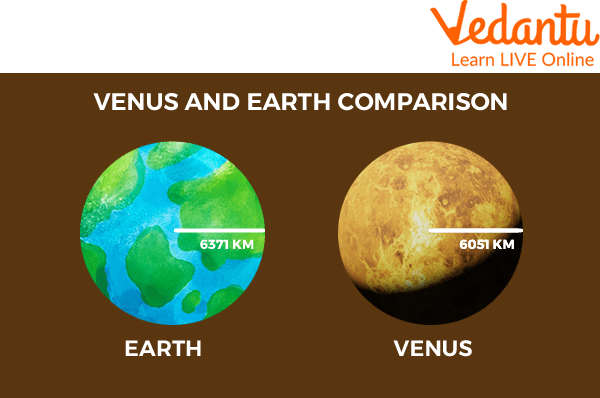




Why Study Venus? Essential Insights for Young Learners
Kids, do you know how the planet Venus was named? Venus was named after the ancient Roman goddess of beauty. Venus is known for its extraordinary brightness in the night sky. But behind the facade is a world of storms and infernos, unlike anywhere else in the solar system.
Venus is the second planet from the sun and is very similar to Earth from a distance. But looking closely, it is a very different world. Venus is just slightly smaller. About the same size as Earth, its structure is nearly identical, with an iron core, a hot mantle, and a rocky crust. Let's learn some information about Venus and fun facts about Venus.
The Brightest Planet 'Venus' and Its Information
Venus is the brightest planet and the second planet from the Sun. Let's learn some important information about Venus:
Venus is the sixth-largest and second planet from the sun in our solar system. This planet consists of mountains, valleys, and thousands of volcanoes.
The radius of Venus is 3,760 miles, and a diameter of 7,521 miles, slightly smaller than earth. Because of these similarities with earth in terms of size, structure, and chemical composition, it is often called earth's twin.
The significant difference between the earth and Venus is that Venus rotates on its axis backwards, which is in contrast to most other solar planets.
On Venus, the sun rises in the west and sets in the east, opposite to what happens on Earth.
Venus reflects 70 per cent of all sunlight it receives from the sun, and this is the reason that it is considered the second brightest object in the solar system after the moon and the sun.
Venus' entire surface is covered with clouds made of poisonous sulphur dioxide, giving enough reasons not to step on the planet.
Venus has crushing air pressure at its surface, which is more than 90 times that of earth. This is the pressure you'd encounter a mile below the ocean on earth.

Venus is the Hottest Planet
Interesting Facts About Venus
Now, let's learn some interesting facts about venus:
The crust of Venus is dotted with thousands of volcanoes, including Maxwell Montes, a volcano almost as tall as Mount Everest.
Venus also has a thick layered atmosphere. It has clouds that rain sulphuric acid and covers the planet and move at speeds of up to 224 miles per hour.
The atmosphere is so thick that it creates a surface pressure similar to what would be about half a mile deep in the Earth's ocean, which is 90 times more pressure than the sea level.
The pressure is heavy enough that a human standing on Venus' surface would be crushed. This happens because Venus is the hottest of all other planets.
The atmosphere of Venus is made up primarily of carbon dioxide, a greenhouse gas. This creates an extreme case of global warming. They trap the sun's heat, causing surface temperature to rise over 800 degrees Fahrenheit.
Venus is very inhospitable. Neither humans nor spacecraft can survive on its surface.
Scientists have found abnormal UV radiation about 30 miles above Venus's Clouds, where the surface temperature and pressure are similar to earth. This wonderful event can be evidence of microbial life.
What Does This Brightest Planet Look like?
Now that we have learned many interesting facts about Venus. Let's see how this planet looks with a few amazing pictures taken by the satellites which studied Venus.

Size Comparison of Venus and Earth
Summary
From this article about Venus facts for kids, we have learnt a lot of information about Venus. Venus has a shining appearance in the sky, and microbial life may be supported in the atmosphere of the planet. We might call Venus the planet of love, but landing on its surface is not lovely. After mercury, Venus is the second planet orbiting the sun and is the sixth-largest planet in our solar system. Because of its brilliance, humans have observed Venus for a very long time.
Venus is 45 million miles from earth, yet it is the closest to our planet. A day on Venus is 243 Earth days, and it rotates much more slowly as compared to Earth.
FAQs on Key Venus Facts Every Student Should Know
1. What colour is Venus?
Venus has a bright, yellowish-white appearance when viewed from a distance. This is because the planet is completely covered by a thick atmosphere of carbon dioxide and clouds made of sulphuric acid, which reflect sunlight and give it this distinct colour.
2. Why is Venus called the 'morning star' and 'evening star'?
Venus is often called the 'morning star' or 'evening star' because its orbit is inside Earth's orbit, so it always appears close to the Sun in the sky. It is one of the first 'stars' to appear after sunset or one of the last to disappear before sunrise, making it a bright beacon in the twilight sky.
3. Does Venus have any moons?
No, Venus does not have any moons. It is one of only two planets in our solar system without a natural satellite (the other being Mercury). The main reason is its close proximity to the Sun, whose powerful gravity would likely capture or disrupt the orbit of any moon that got too close to Venus.
4. Is a day on Venus really longer than its year?
Yes, this is a fascinating fact about Venus. A year on Venus, which is the time it takes to orbit the Sun, is about 225 Earth days. However, a single day on Venus, meaning one full rotation, takes about 243 Earth days. So, its day is strangely longer than its year!
5. Why is Venus the hottest planet, even though it's not the closest to the Sun?
Although Mercury is closer to the Sun, Venus is the hottest planet due to its runaway greenhouse effect. Its extremely thick atmosphere is full of carbon dioxide, which acts like a heavy blanket, trapping the Sun's heat. This makes the surface temperature soar to about 465°C, which is hot enough to melt lead.
6. Why is Venus sometimes called Earth's 'twin sister'?
Venus is called Earth's 'twin sister' mainly because of similarities in their physical properties. However, they are not identical twins. Key similarities include:
- Size and Mass: Venus is only slightly smaller than Earth.
- Composition: Both are terrestrial (rocky) planets made of similar materials.
7. Why couldn't we live on Venus?
Humans could not survive on Venus for several critical reasons. The planet's environment is extremely hostile, featuring:
- Extreme Heat: Surface temperatures are hotter than a kitchen oven.
- Crushing Pressure: The atmospheric pressure is over 90 times that of Earth's, which would crush a person.
- Toxic Air: The atmosphere is mostly carbon dioxide with clouds of sulphuric acid, making it unbreathable and corrosive.
8. What is unique about the way Venus spins?
Venus has a unique and slow rotation known as retrograde rotation. This means it spins 'backwards' compared to Earth and most other planets in the solar system. If you could stand on the surface of Venus, you would see the Sun rise in the west and set in the east. This unusual spin also contributes to its incredibly long day.









